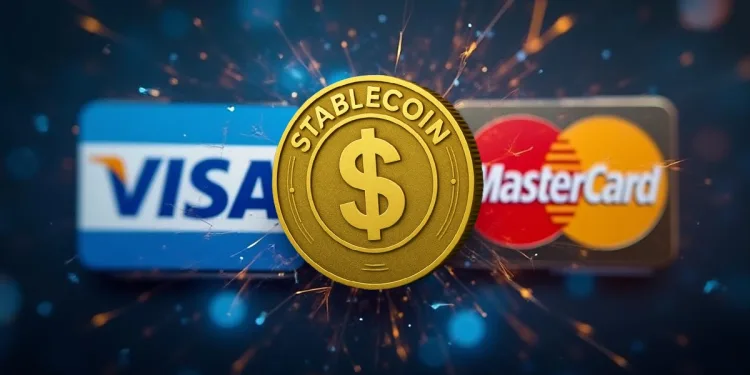- Visa and Mastercard report that stablecoins currently have negligible adoption compared to their $15 trillion annual transaction volume.
- Both firms recognize that stablecoins may gain traction in countries with unstable fiat currencies, such as Argentina and Venezuela.
- Despite discussions around stablecoins, Mastercard reported a 16.8% revenue increase while Visa’s U.S. card volume growth outpaced Mastercard for the first time since Q4 2023.
The emergence of stablecoins, or digital currencies that are tied to fiat currencies such as the U.S. dollar, is modest so far on the world stage of transactions. Unlike volatile cryptocurrencies like Bitcoin, stablecoins provide a stable price and are considered helpful in cross border payments.
Even with such potential, some of the most significant financial greasing systems Visa and Mastercard have already made it clear that the adoption of stablecoins has not surpassed the extent that threatens them in their dominant stance in the payment market. In recent earnings calls, both companies emphasized that current usage is too small to affect their vast transaction volumes. For instance, Visa processes over $15 trillion annually, while stablecoin activity falls far short of that scale.
Stablecoins Seen as Niche Tools, Not Mainstream Payment Solutions
During their respective quarterly earnings briefings, both Visa and Mastercard stated that stablecoins currently serve a niche role. They noted that while these digital assets offer certain efficiencies, especially for cross-border transfers, consumer preference remains largely in favor of traditional banking methods. According to Visa, stablecoin usage today is negligible in comparison to its global payments infrastructure.
Mastercard echoed a similar stance. While acknowledging the emergence of blockchain-based alternatives, the company maintained that mainstream customers are not adopting them at meaningful levels. However, both firms did not dismiss the potential entirely. They indicated that in certain markets, particularly those with volatile local currencies, stablecoins may gain traction as a tool for financial stability.
Inflation-Hit Countries Show Higher Stablecoin Activity
Both companies cited examples of countries such as Venezuela and Argentina, where inflation is currently a severe issue. In these economies, citizens will occasionally resort to dollar-pegged stablecoins in order to preserve the purchasing power of their money. Mastercard also pointed out that these markets may see greater stablecoin use as citizens attempt to find ways around devalued local currencies.
Visa also acknowledged this pattern, noting that the lack of reliable banking systems in some regions makes digital assets a practical solution. However, neither company suggested that this growth poses a near-term risk to their operations. Instead, they see stablecoins as supplementary, with limited impact outside specific regions.
Strong Financial Performance Reinforces Market Leadership
Despite the attention on digital assets, both companies reported strong financial results. Mastercard’s revenue, on a year-over-year basis, was up 16.8%, at $8.13 billion. Operating income was $4.87 billion, with a 60% margin, and free cash flow was $4.56 billion—a 56% margin, up 12.7 points year over year.
Visa’s performance also caught the eye. Its U.S. card payment volume expanded more than Mastercard’s for the first time since Q4 2023. Visa shares rose 31% over the last year, while Mastercard’s went up by 24%. Despite emerging technologies, these results demonstrate the continued strength of their payment ecosystems.














